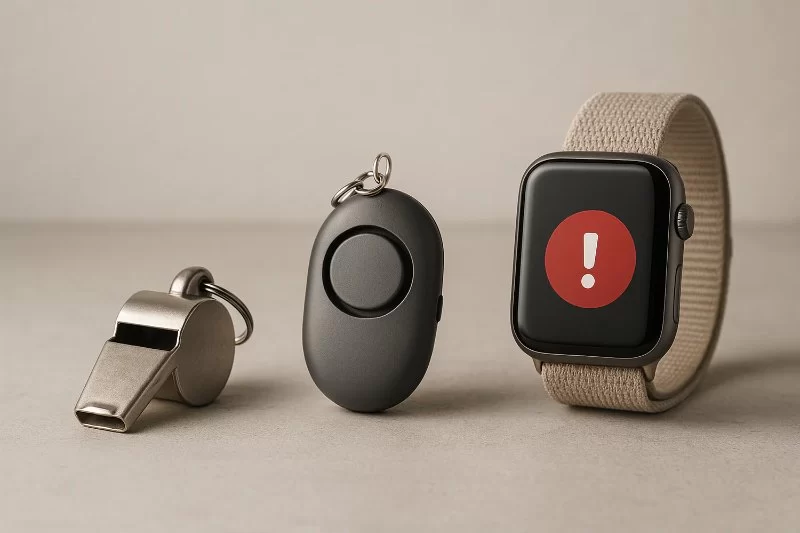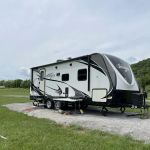
- 1 - Why personal safety alarms and whistles belong in every travel kit
- 2 - How safety alarms and whistles work in crowded cities, trails, and campsites
- 3 - Personal safety alarms vs. whistles: when to choose each tool
- 4 - How to carry and use alarms and whistles for fast, confident response
- 5 - Real traveler stories: moments when small tools made a big difference
- 6 - What to look for: loudness, battery life, durability, and design
- 7 - Laws, etiquette, and TSA considerations for U.S. travelers
- 8 - Maintenance and hygiene: keeping devices reliable on long trips
- 9 - Packing plans and checklists you can copy before your next trip
- 10 - Expert picks and how Refined Travel helps you choose confidently
1 - Why personal safety alarms and whistles belong in every travel kit
1.1 - Small tools, outsized peace of mind
Whether you are catching a red-eye into a busy U.S. gateway city, walking from a national park trailhead at dusk, or returning to your campsite after stargazing, a pocket-size safety tool is the fastest way to turn attention in your favor. The best personal safety alarms and whistles do not promise invincibility—they buy you seconds, create distance, and summon help. Those seconds are often the difference between a bad scare and a bad outcome.
1.2 - Why sound matters more than strength
Loud, startling sound interrupts patterns. A 120–140 dB alarm or an emergency whistle pierces background noise, drawing eyes and phone cameras—powerful deterrents. This is especially helpful for solo travelers, students, festivalgoers, new RV owners, and anyone exploring unfamiliar neighborhoods after dark. The simplicity matters: pull a pin, press a button, or blow a whistle. No apps to load, no unlock codes to fumble.
1.3 - The confidence effect
Carrying a device you’ve practiced with changes posture and decision-making. People walk straighter, scan smarter, and avoid risky detours. Confidence itself deters opportunistic threats. Building that confidence is a theme throughout this guide to the best personal safety alarms and whistles for travelers.
2 - How safety alarms and whistles work in crowded cities, trails, and campsites
2.1 - Urban noise vs. alarm pitch
City soundscapes can swallow typical conversation but not certain frequencies. Many alarms use shrill, oscillating tones that cut through buses, music, and street chatter. The goal is not just volume; it is an attention-grabbing pitch that makes bystanders look up and locate you quickly. In transit hubs, the echo effect in structures like parking garages can amplify the perceived directionality of sound.
2.2 - Trails, deserts, and canyons
In open terrain, high-pitched whistles travel surprisingly far with minimal effort. A three-blast pattern is a widely recognized distress signal in outdoor communities. On breezy ridgelines where phone bars fade to zero, a whistle remains reliable, weightless, and immune to dead batteries.
2.3 - Campgrounds and RV parks
Campgrounds are social by design. Noise curfews keep nights quiet, which makes alarms even more conspicuous if used in a real emergency. For non-emergencies—like locating a child who wandered behind the loop—a whistle is polite and effective without startling the entire campground.
3 - Personal safety alarms vs. whistles: when to choose each tool
3.1 - Choose an alarm when hands are full or speed matters
An alarm with a simple pull-pin activates instantly while you hold luggage, a stroller, or groceries. Many models include a bright strobe to help cameras spot you. If you commute at night or use multi-level parking structures, the best personal safety alarms provide the fastest “press-and-shout” response in tight quarters.
3.2 - Choose a whistle for power-out, off-grid, or wet environments
Whistles excel where electronics fail: heavy rain, river crossings, salt spray, or snow. They are practically unbreakable, weigh next to nothing, and never need charging. Coaches and search-and-rescue teams prefer pea-less designs that won’t jam with moisture or freeze in winter conditions.
3.3 - Why most travelers carry both
Redundancy is smart. Keep a whistle tethered to your daypack sternum strap and an alarm clipped to a pocket or key leash. One stays with your pack; one stays with your person. In stressful moments, the device you can reach blind is the right choice.
4 - How to carry and use alarms and whistles for fast, confident response
4.1 - Clip zones and muscle memory
Practice until your fingers can deploy without looking. Best placements include the leading edge of a jacket placket, a key leash in a front pocket, a purse strap, or a backpack shoulder strap. Avoid burying devices in zippered pouches; seconds count. Run drills: pull, activate, pivot to crowds or cameras, and move to lighted areas.
4.2 - Patterns that help rescuers
For whistles, three sharp blasts, pause, repeat. For alarms, keep the sound continuous while you move toward visibility. If safe, shout your location: “Level two, north stairwell,” “Campsite 27, river loop,” or “Blue SUV, row C.” The combination of specific words plus sound helps helpers orient quickly.
4.3 - Pair with lights and phones
Layer your safety stack: alarm or whistle + small headlamp + charged phone with emergency contacts favorited. Many alarms integrate LEDs; if yours does not, carry a thumb-size keylight on the same clip. The light draws eyes to the sound source and helps you navigate away from hazards.
5 - Real traveler stories: moments when small tools made a big difference
5.1 - Late-night garage in Austin
After a concert, a solo traveler returned to a dim garage. A figure trailed two car lengths back, then quickened pace. She pulled her alarm and let it scream while stepping into the drive lane under brighter lights. The shadow peeled off. Two people from another row shouted, “You okay?” The moment passed, but the signal—and her rehearsed plan—changed the outcome.
5.2 - Fog on the Oregon coast
At a foggy cliff-top campground, a family’s child slipped behind boulders near twilight. Cell coverage flickered. The parent blew three sharp whistle blasts; within seconds, neighboring campers echoed with “Coming!” The child, hearing the familiar tone, called back from a pocket of brush. No panic, no search party—just a simple tool and a practiced signal.
5.3 - Daypack theft deterred in New Orleans
A pickpocket tugged at a traveler’s backpack in a crowded streetcar. The traveler’s alarm, tethered to the sternum strap, blared the instant the pin moved. The thief let go, and the driver stopped the car. Witnesses pointed, phones came out, and the traveler kept the pack—and the evening.
6 - What to look for: loudness, battery life, durability, and design
6.1 - Loudness and tone
Look for stated outputs of 120–140 dB for alarms and for whistles marketed as emergency-grade. Numbers on packaging can be optimistic; prioritize brands with consistent reviews about “ear-splitting” sound and a piercing pitch. Tone matters: steady shriek or oscillation tends to carry best through mixed noise.
6.2 - Power and endurance
Rechargeable micro-USB or USB-C alarms are convenient for multi-week trips; coin-cell models are lighter but require spares. A good alarm should hold charge for months in standby and deliver multiple long blasts per charge. Test monthly and top off with your other travel electronics.
6.3 - Build, weatherproofing, and ergonomics
Choose drop-resistant housings with secure, snag-resistant pins or buttons. For the outdoors, look for IP-rated splash resistance. For whistles, prefer pea-less, high-impact ABS or aluminum designs with a lanyard and reflective cord.
6.4 - Size, weight, and carry options
Devices that are too bulky migrate to the bottom of bags. Aim for under two ounces for alarms and under one ounce for whistles. Integrated clips and carabiner rings make daily carry frictionless.
7 - Laws, etiquette, and TSA considerations for U.S. travelers
7.1 - Where alarms are permitted
Personal alarms and whistles are generally legal across U.S. states and are widely allowed at concerts, campuses, museums, and sporting events. Venues may restrict air horns or pressurized canisters; check policies for large arenas and national parks if you plan to carry louder signaling tools.
7.2 - Air travel tips
Most electronic alarms and plastic whistles can fly in carry-on or checked bags. Pack alarms so they will not activate accidentally; use a travel switch cover or tape over the button and separate the pull pin if possible. If a screamer goes off at security, it slows everyone—including you.
7.3 - Etiquette and responsible use
Treat sound as a safety resource, not a toy. False alarms reduce bystander responsiveness. Use whistles as a meet-up cue with kids in crowds, but reserve sustained blasts for real emergencies. Teach children the difference with simple rules and practice sessions.
8 - Maintenance and hygiene: keeping devices reliable on long trips
8.1 - Monthly function checks
Test alarms for two seconds to verify loudness, then reinsert pins firmly. For whistles, check the lanyard and ensure no cracks or warping. Keep a tiny silica gel packet in your kit to reduce moisture exposure.
8.2 - Cleaning and COVID-aware hygiene
Whistles come in contact with your mouth—clean them with warm water and mild soap, then air-dry fully. Avoid harsh solvents that degrade plastics. For shared gear, assign color-coded lanyards to prevent swaps.
8.3 - Storage and redundancy
Store one device on your person and one in your daypack. In hotels, clip an alarm to your pajama waistband or nightstand drawer pull so you can reach it in the dark. In camp, secure one to your headlamp strap.
9 - Packing plans and checklists you can copy before your next trip
9.1 - City weekend
One rechargeable alarm, one lightweight whistle, keylight, slim power bank, and a pocket card with emergency contacts. Practice exiting rideshares and garages with your alarm hand free.
9.2 - National park loop
One whistle on sternum strap, one alarm on pocket clip, backup coin cells or charging cable, reflective lanyard, headlamp. Agree on a three-blast meet-up signal before the trailhead.
9.3 - Family road trip
Assign devices to each traveler. Demonstrate “press and move to light” and “three-blast, pause, repeat.” Place a spare whistle in the glove box and one in the picnic tote.
10 - Expert picks and how Refined Travel helps you choose confidently
10.1 - Quick shortlist by use case
Everyday carry: A palm-size, 120–130 dB alarm with a protected button and USB-C charging for commuters and students. Backcountry: A pea-less emergency whistle with reflective lanyard for hikers, paddlers, and campers. Family travel: Color-coded whistles and alarms so kids can identify theirs instantly.
10.2 - Why curated advice beats random scrolling
The marketplace is full of look-alike gadgets with inflated claims. Comparing the best personal safety alarms and whistles means verifying true loudness, testing ergonomics with gloves, and assessing clip strength. That is exactly where Refined Travel shines—curating gear combinations that match your itinerary, climate, and carry style, and pointing you to trusted retailers and outfitters for easy, confident purchasing.
10.3 - Make your next trip feel lighter—and safer
Add one alarm and one whistle to your kit this week, run a two-minute practice, and you will feel the difference on your very next outing. If you want tailored suggestions or a destination-specific packing list, reach out to Refined Travel for expert, traveler-tested guidance that keeps your adventures focused on discovery—not worry.







 Pala Verde Mobile Home & RV Park3.0 (79 reviews)
Pala Verde Mobile Home & RV Park3.0 (79 reviews) Rosemount Woods3.0 (23 reviews)
Rosemount Woods3.0 (23 reviews) Lake Douglas Village5.0 (4 reviews)
Lake Douglas Village5.0 (4 reviews) Crooked Creek Horse Camp5.0 (1 reviews)
Crooked Creek Horse Camp5.0 (1 reviews) Smalltown Campsites, LLC5.0 (40 reviews)
Smalltown Campsites, LLC5.0 (40 reviews) Coyote Campground4.0 (31 reviews)
Coyote Campground4.0 (31 reviews) Exclusive Travel Packages for First-Class Travelers: A Guide to Luxury Vacations
Exclusive Travel Packages for First-Class Travelers: A Guide to Luxury Vacations Refined Travel Experiences in Southeast Asia: Explore Luxury & Unique Destinations
Refined Travel Experiences in Southeast Asia: Explore Luxury & Unique Destinations How to Make the Most of Luxury Vacation Deals: Expert Tips for Savvy Travelers
How to Make the Most of Luxury Vacation Deals: Expert Tips for Savvy Travelers How to Enjoy a Refined Travel Experience in the Mountains
How to Enjoy a Refined Travel Experience in the Mountains Refined Travel Itineraries for Art and Culture Lovers: Explore the World of Art and History
Refined Travel Itineraries for Art and Culture Lovers: Explore the World of Art and History Most Luxurious Destinations for Honeymooners: Top Spots for Romance and Luxury
Most Luxurious Destinations for Honeymooners: Top Spots for Romance and Luxury